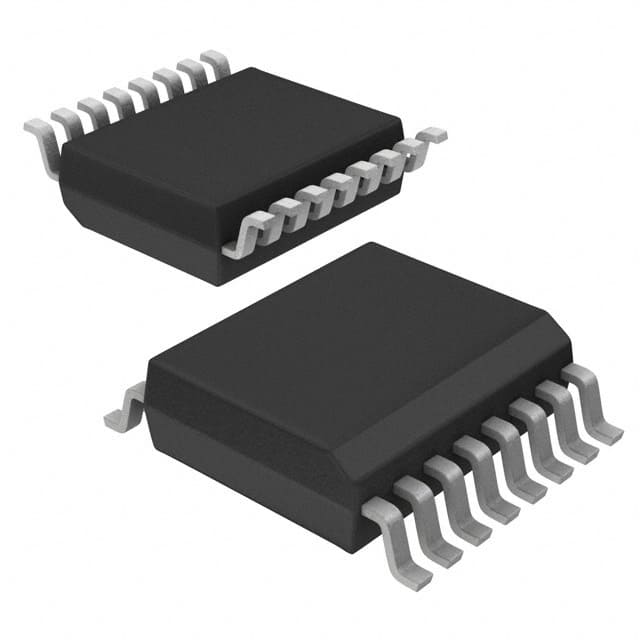Encyclopedia Entry: 74CBTLV3257DS-Q10J
Product Overview
Category
The 74CBTLV3257DS-Q10J belongs to the category of integrated circuits (ICs) and specifically falls under the classification of multiplexers/demultiplexers.
Use
This product is primarily used for signal routing and switching applications in electronic circuits. It enables the selection of one of multiple input signals to be routed to a single output line.
Characteristics
- Low voltage operation: The 74CBTLV3257DS-Q10J operates at low voltages, typically between 1.65V and 3.6V.
- High-speed switching: It offers fast switching times, allowing for efficient signal routing.
- Low power consumption: This IC is designed to consume minimal power, making it suitable for portable and battery-powered devices.
- Wide temperature range: It can operate reliably across a wide temperature range, from -40°C to +125°C.
Package and Quantity
The 74CBTLV3257DS-Q10J is available in a small outline package (SOP) with 16 pins. It is commonly supplied in tape and reel packaging, with a quantity of 2500 units per reel.
Specifications
- Supply Voltage Range: 1.65V to 3.6V
- Input/Output Voltage Range: GND to VCC
- On-state Resistance: 4Ω (typical)
- Bandwidth: 500MHz (typical)
- Maximum Operating Frequency: 200MHz
- Input Capacitance: 2pF (typical)
- Leakage Current: 1nA (maximum)
Pin Configuration
The 74CBTLV3257DS-Q10J has a total of 16 pins, which are assigned specific functions as follows:
Pin 1: Output Y
Pin 2: Input/Output Enable (OE)
Pin 3: Select Input S0
Pin 4: Select Input S1
Pin 5: Select Input S2
Pin 6: Ground (GND)
Pin 7: Input A0
Pin 8: Input B0
Pin 9: Input A1
Pin 10: Input B1
Pin 11: Input A2
Pin 12: Input B2
Pin 13: VCC
Pin 14: Input A3
Pin 15: Input B3
Pin 16: Not Connected (NC)
Functional Features
The 74CBTLV3257DS-Q10J offers the following functional features:
- Quad 1-of-2 multiplexer/demultiplexer: It allows for the selection of one of two input signals to be routed to the output line.
- Independent control inputs: The select inputs (S0, S1, and S2) enable the user to choose the desired input signal.
- Output enable control: The OE pin enables or disables the output, providing flexibility in signal routing.
Advantages and Disadvantages
Advantages
- Low voltage operation makes it compatible with a wide range of electronic systems.
- High-speed switching ensures efficient signal routing.
- Low power consumption extends battery life in portable devices.
- Wide temperature range allows for reliable operation in various environments.
Disadvantages
- Limited to 1-of-2 multiplexing/demultiplexing functionality.
- May not be suitable for applications requiring higher channel count.
Working Principles
The 74CBTLV3257DS-Q10J operates based on the principles of multiplexing and demultiplexing. When the appropriate select inputs (S0, S1, and S2) are set, the IC routes the selected input signal to the output line (Y). The OE pin controls the output enable/disable functionality.
Application Field Plans
The 74CBTLV3257DS-Q10J finds applications in various electronic systems, including but not limited to:
- Data communication devices: Used for signal routing in routers, switches, and network equipment.
- Test and measurement instruments: Enables signal switching in oscilloscopes, logic analyzers, and function generators.
- Audio/video equipment: Facilitates signal selection in audio/video switchers and matrix switchers.
- Industrial automation: Utilized in control systems for signal routing and switching.
- Automotive electronics: Enables signal routing in automotive infotainment systems and control modules.
Alternative Models
For users seeking alternative options, the following models can be considered:
- 74CBTLV3253DS-Q100J
- 74CBTLV3257PW-Q100J
- 74CBTLV3257DGVR
These models offer similar functionality and characteristics, providing alternatives based on specific requirements.
In conclusion, the 74CBTLV
Seznam 10 běžných otázek a odpovědí souvisejících s aplikací 74CBTLV3257DS-Q10J v technických řešeních
Sure! Here are 10 common questions and answers related to the application of 74CBTLV3257DS-Q10J in technical solutions:
Q: What is the function of the 74CBTLV3257DS-Q10J? A: The 74CBTLV3257DS-Q10J is a quad 2-channel multiplexer/demultiplexer switch used for routing digital signals in electronic circuits.
Q: What is the voltage range supported by the 74CBTLV3257DS-Q10J? A: The 74CBTLV3257DS-Q10J supports a voltage range from 1.65V to 3.6V.
Q: How many channels does the 74CBTLV3257DS-Q10J have? A: The 74CBTLV3257DS-Q10J has four channels, each with two inputs and one output.
Q: Can the 74CBTLV3257DS-Q10J be used for bidirectional signal routing? A: Yes, the 74CBTLV3257DS-Q10J can be used for bidirectional signal routing, allowing signals to flow in both directions.
Q: What is the maximum data rate supported by the 74CBTLV3257DS-Q10J? A: The 74CBTLV3257DS-Q10J supports a maximum data rate of 400 Mbps.
Q: Is the 74CBTLV3257DS-Q10J compatible with I2C and SPI protocols? A: Yes, the 74CBTLV3257DS-Q10J is compatible with I2C and SPI protocols, making it suitable for various communication interfaces.
Q: Can the 74CBTLV3257DS-Q10J handle analog signals? A: No, the 74CBTLV3257DS-Q10J is designed for digital signals and may not be suitable for handling analog signals.
Q: What is the power supply voltage required for the 74CBTLV3257DS-Q10J? A: The 74CBTLV3257DS-Q10J requires a power supply voltage of 1.65V to 3.6V.
Q: Does the 74CBTLV3257DS-Q10J have built-in ESD protection? A: Yes, the 74CBTLV3257DS-Q10J has built-in ESD protection, providing robustness against electrostatic discharge.
Q: Can the 74CBTLV3257DS-Q10J be used in automotive applications? A: Yes, the 74CBTLV3257DS-Q10J is qualified for automotive applications and can operate in harsh environments.
Please note that these answers are general and may vary depending on the specific application and requirements.


